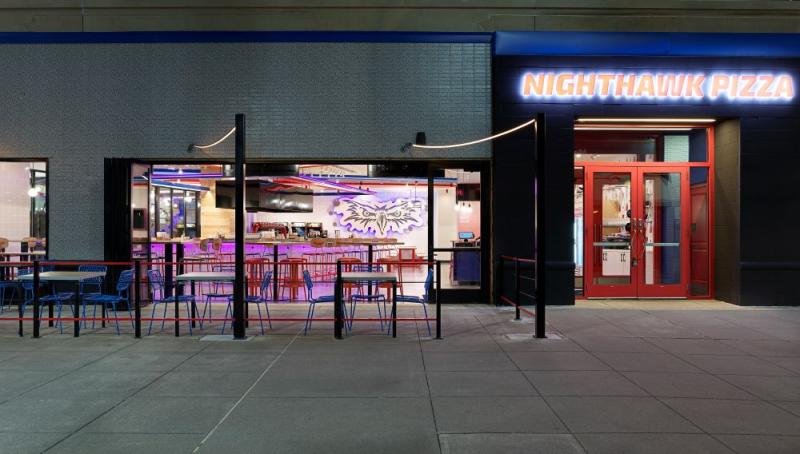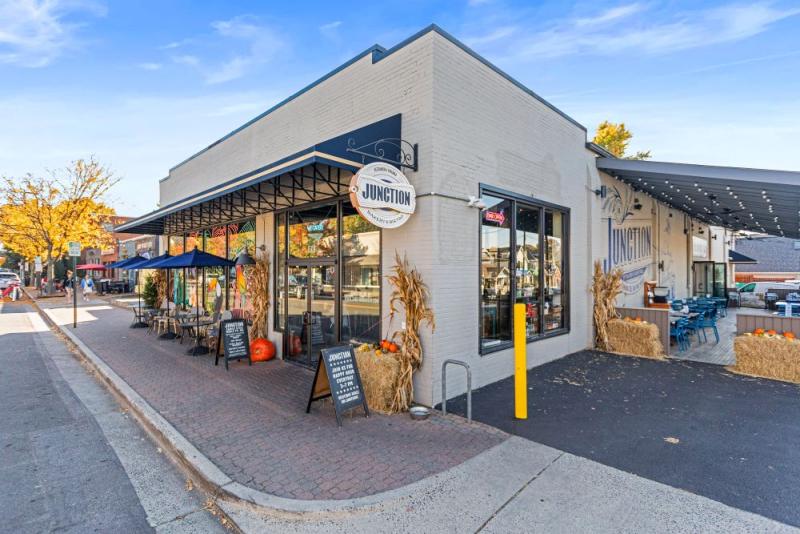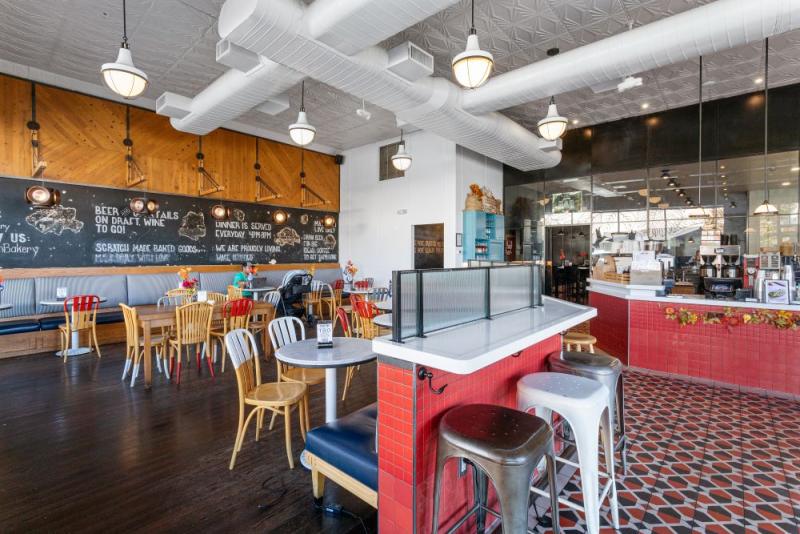One could say the restaurant industry featured a bit of Dickensian flavor last year—a “best of times, worst of times” situation, if you will. On one hand, the industry continued to grow as a whole, with the National Restaurant Association celebrating an expected record-breaking total sales of $1.1 trillion in 2024. Yet, on the other hand, long-recognizable chain brands such as Wendy’s, Applebee’s, and Denny’s downsized locations due to rising costs and underperforming stores, and TGI Fridays and Red Lobster outright filed for bankruptcy.
While the latter examples give some pause, a silver lining is emerging from them. As the long-time mantra goes, it’s all about “real estate, real estate, real estate!” These increasing vacancies are creating opportunities for new and expanding food & beverage (F&B) brands to take their place.
Fast-casual chains, as well as smaller dining chains, are claiming these vacant freestanding spots and transforming them to better fit their needs. And it’s no wonder why: The current U.S. retail vacancy rate rests at 4.1 percent, the lowest rate in decades and a driving force behind the high demand for vacant space in a tight market.
Of course, it’s not just important to secure space for either a restaurant relocation, expansion, or new opening, it’s equally important how restauranteurs use the space.

Is It the Food or the Atmosphere?
The hospitality experts at Washington, D.C.-based //3877, a multi-disciplinary architecture and design firm co-founded by David Shove-Brown and David Tracz that focuses on restaurant and hospitality (as well as commercial and residential projects), have extensive experience bringing restaurants to life across the region and beyond. They say the key to restaurant revivals in pre-existing real estate lies in crafting environments that entice people to return, particularly those who over the past few years have abandoned traditional sit-down for cheaper stay-at-home options.
“Today’s diners seek more than just great food,” said Tracz. “They want an immersive and memorable experience that keeps them coming back.”
Fast casual restaurants such as taco shops and upscale burger joints are really attracted to the newly available real estate thanks to the prime locations and cheaper rent. “Even with the closure of some chain restaurants as seen in the news, fast food and convenience will always be a prevalent part of the market—just look at the resurgence of Chili’s, for example,” remarked Shove-Brown. “However, with prices rising, customers are choosier about where they spend their money. This has led to a growing appeal for unique dining experiences and fast-casual concepts.
“While this shift isn’t entirely new, it has gained momentum post-pandemic as consumers place greater value on the overall dining experience [and] not just the food itself.”
Designs on the Perfect Space
So is there a major ingredient for restaurant operators to consider when looking to attract today’s dining consumers through experience? When approaching any F&B design, the experts at //3877 believe in creating a space that provides depth and layers.
“Incorporating themes from the menu or locally inspired elements creates a rich, multi-layered dining experience for guests that they can’t find anywhere else,” said Tracz. “I urge owners to really think about their overall brand concept. I’m not just talking about throwing a logo on the wall—it’s about paying attention to details that tie each element of the experience together, including furniture, materiality, color palette, and lighting selections. All of these factor into the creation of a cohesive, immersive brand expression that leaves diners with a distinct sense of who you are and what they can expect.”

Shove-Brown and Tracz explained that by repurposing the existing infrastructure of the vacant buildings, restauranteurs can bring about new concepts with ease. “Many vacated properties already include essential elements like plumbing lines, ventilation systems, and kitchen layouts, which can significantly reduce the cost and time associated with establishing a physical space,” they commented. “By adopting these pre-existing features, operators can focus their resources on innovating their concepts and designing an inviting atmosphere that resonates with diners.”
Keep in mind that taking on pre-existing trade fixtures for a new opening has its advantages, but it also has disadvantages. “One of our clients was able to reuse some of the existing tables and chairs left over from the previous F&B space, as they were in good shape and fit into the new design concept,” said Shove-Brown. “However, if the fixtures are not in good condition, you could end up spending more money trying to find someone to move, repair, and re-install them. Kitchen equipment or lighting fixtures, for example, may be more costly to repair than buying new.”
“We always recommend talking with your architect first and working with a kitchen consultant who can assess equipment to see if it’s worth fixing up or not,” said Tracz. “We once had a client who went ahead and purchased a bunch of tiles that they loved and ended up not being able to use due to their low slip resistance, which would not work in a restaurant.”
When opening a brand-new concept, Tracz said it’s important to think about your audience and the pre-existing location you are choosing. “Are you looking for a lot of sit-down space or room for grab-and-go options? Does the building footprint support the infrastructure you need? Operations need to be at the forefront of that conversation to execute a concept as seamlessly as possible,” he advised.
Shove-Brown does say his firm isn’t really seeing many restaurant clients choosing to upsize their spaces these days. “Taking on additional space automatically changes the existing infrastructure and flow of the existing business, making it a large undertaking,” he stated. “Instead, brands often choose to expand by starting a new branch in a different part of town.”
If the new space isn’t perfect for your business model, look at how much money and energy you’re willing to invest versus saving money with the existing infrastructure. “However, when properly planned, the right match between the type of restaurant and its location can turn a previously unsuccessful space into a thriving new business,” confirmed Tracz.
Having a (Floor) Plan in Place
When it comes to mistakes restaurant operators need to avoid when searching for real estate space, it’s important to weigh the pros and cons of the existing floorplan, considering how much work will need to be done in order to create a good flow for employees and guests.
“In a lot of cases, you see one hallway providing a single access point for the bathrooms and back-of-house areas,” said Shove-Brown. “This can create collisions and bottlenecks, negatively impacting your operations as well as the customer experience. You want to make things as easy as possible for everyone using the space by providing multiple clear access points to different areas if you can.
“For example, one of our clients wanted to keep the existing restroom in their new location to save money,” detailed Tracz. “But in order to make that happen, they would have to sacrifice the needs of the kitchen and service counter, which screws up their flow and business model. In the end, it made more sense in the long run, financially, to demo it and install new infrastructure.”

The Wait Time
As a restaurant operator, you may be plotting a quick move or longer-term strategizing. Shove-Brown and Tracz said that the renovation timeline for any F&B location depends on the existing infrastructure and needs of the new restaurant.
“By repurposing real estate that was previously used for F&B, owners can take advantage of much of the existing infrastructure needed for a restaurant—plumbing, ventilation, bar setups, and footing for kitchen equipment,” said Tracz. “Additionally, these buildings often offer the right occupancy, number of restrooms, and parking spaces that restaurants require. This can help save time and money when building a new restaurant concept, cutting costs and opening up opportunities for restauranteurs to transform these spaces into original concepts.”
“However, if the infrastructure is outdated or broken beyond repair, it could end up costing more money in the long run,” added Shove-Brown. “It’s all about being strategic in your selection. You don’t want to force a fit when it's not the best choice for your specific concept.
A List of Leases
When opening a restaurant, you’ll find there are different types of commercial lease options to gauge:
- A percentage lease (where you pay a percentage of the gross or net income as rent);
- A net lease (pay rent plus all or some of the property charges);
- A graduated lease (pay a rent that increases at pre-determined dates);
- A full-service lease (rent plus share in overall operating expenses with other tenants); and
- A ground lease (rent the land and build/teardown on it).
There’s no universal answer to which is best; it really depends on your needs. “We’re all for landlords getting some of the distributed profits, adding another ally to the business where everyone benefits,” said Tracz. “However, it really depends on your situation and business. There are so many variables here based on the lease and length of the lease, you can’t simply choose which is best with a blanket statement. In actuality, it involves a lot of number crunching.
“There are many variables in play here as well—it really depends on the location and business model. One type of lease might work better in a strip mall outside of Houston, while it might not make sense in New York City.”
What’s on the Menu This Year?
An interesting development going into 2025, according to //3877, is that trends are signaling a shift toward a “more thoughtful and cost-efficient” approach to F&B development. “Consumers are eager for fresh dining experiences, and developers are motivated to fill vacant properties, paving the way for innovation,” said Shove-Brown.
In other words, there’s no time like today to present guests with the experience of a lifetime at an empty location you’ve decided to transform as you best see fit.
